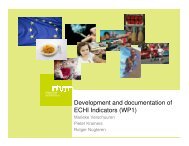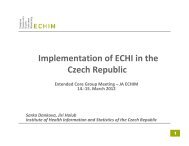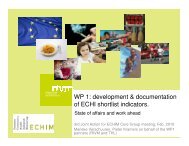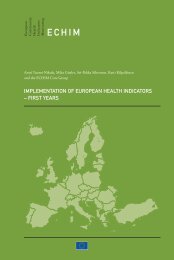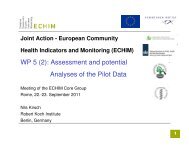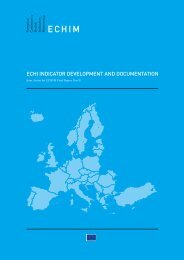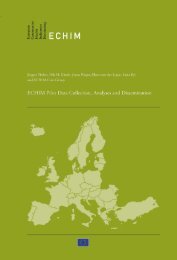INDICATORS
ECHIM Final Report
ECHIM Final Report
You also want an ePaper? Increase the reach of your titles
YUMPU automatically turns print PDFs into web optimized ePapers that Google loves.
Notes: Exclusive versus partial breastfeeding. The WHO recommends exclusive breastfeeding<br />
for the first six months of life, and subsequent breastfeeding with appropriate complementary<br />
foods while breastfeeding continues for up to two years of age or beyond. Eurodiet-project:<br />
The average population goal is around 6 months, but for individuals exclusive breastfeeding<br />
should continue for at least four months and breastfeeding should be the principal source of<br />
milk for the infant until one year of age.<br />
Comparisons among countries are not easy; the definitions, questions, recall period and<br />
methods of data collection are different, not all countries gather regular data on breastfeeding<br />
and few has data on trends.<br />
52. PHYSICAL ACTIVITY<br />
Definition: This indicator is referring to the concept of “health-enhancing physical<br />
activity”. It is covering a whole range of physical activities including leisure time physical<br />
activities, exercises, sport, occupational activities, commuting and daily tasks. Physical<br />
activity is defined as any bodily movement produced by skeletal muscle that results in energy<br />
expenditure.<br />
Calculation:<br />
1) EHIS instrument (deriving from the IPAQ) to measure the proportion of population<br />
performing moderate and vigorous physical activity (days and/or hours per week), derived<br />
from questions PE.1.–6: During the past 7 days, a) days and time devoted to vigorous<br />
physical activities. b) days and time devoted to moderate physical activities c) days and time<br />
spent walking. Precise operationalisation to be formulated.<br />
2) The Health Behaviour of School Children Survey (HBSC, 2001/2002) includes some<br />
questions for children aged 11–13–15: % of children reporting 60 minutes or more of<br />
physical activity of at least moderate intensity on 5 or more days a week, carried out at school<br />
and/or in free-time, a) during both the previous week and b) a typical week, derived from<br />
questions:<br />
Over the past 7 days, on how many days were you physically active for a total of at least 60<br />
minutes per day? Over a typical or usual week, on how many days are you physically active<br />
for a total of at least 60 minutes per day? The response categories for both were: 0 days, 1<br />
day, 2 days, … 7 days.<br />
Notes: Population health surveys allow verifying if the respondents have effectively<br />
performed any type of physical activity. Intensity as well as frequency of the effort is<br />
taken into account. This can be done either through direct measurements (pedometer,<br />
accelerometer) or rather based on the self-declaration of the individuals<br />
Possible operational measures of physical activity level and pattern include: a) The total<br />
amount of activity expressed either as activity energy expenditure (kcal, Joules, MET mins,<br />
etc) or physical activity level (PAL); b) Time (mins/day or week) spent at health enhancing<br />
physical activity level (i.e. activity at moderate and vigorous intensity levels); c) Time (mins/<br />
day or week) spent sitting; d) Proportion of the population reaching the threshold level for<br />
health enhancing physical activity.<br />
European Physical Activity Surveillance System, EUPASS -project stresses 4 key dimensions<br />
of physical activity: type, frequency, duration and intensity of activity. The International<br />
Physical Activity Questionnaire (IPAQ) is considered as the most advanced international<br />
approach to operationalise the dimensions of physical activity<br />
The EHIS questions (PE.1.–6.) are an adaptation of the IPAQ but they have not been<br />
validated.<br />
114



